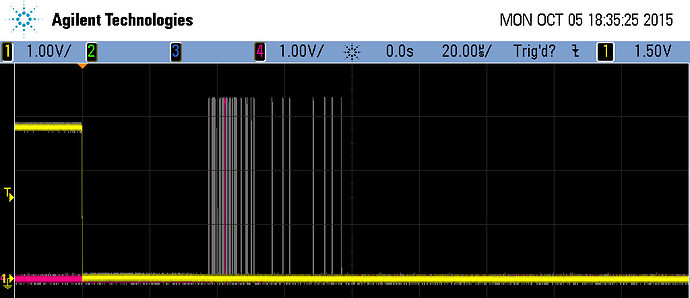Hello everyone,
I have come across a problem on the BBK (Debian 8.2 , 2015-09-11 release) and would be very grateful for a bit of an explanation.
I need to work with the PWMs and therefore I have developed a little ugly script in order to work with config-pin.sh (https://github.com/cdsteinkuehler/beaglebone-universal-io) and then export the pwmchip. Down the line I’d like to to have the script running at start-up, prior to launching a executable.
The cape-universaln overlay is applied. The script goes as follow :
`
#!/bin/bash
echo “Configuring pins”
sudo sh -c ‘/home/debian/beaglebone-universal-io/config-pin P9.22 pwm’
sudo sh -c ‘/home/debian/beaglebone-universal-io/config-pin P9.21 pwm’
sudo sh -c ‘/home/debian/beaglebone-universal-io/config-pin P9.14 pwm’
sudo sh -c ‘/home/debian/beaglebone-universal-io/config-pin P9.16 pwm’
sudo sh -c ‘/home/debian/beaglebone-universal-io/config-pin P8.19 pwm’
sudo sh -c ‘/home/debian/beaglebone-universal-io/config-pin P8.13 pwm’
echo “Export pins”
if sudo sh -c ‘echo “0” > /sys/class/pwm/pwmchip0/export’ ; then
echo “pwmchip0:pwm0 exported”
else echo “pwmchip0:pwm0 export failed”
fi
if sudo sh -c ‘echo “1” > /sys/class/pwm/pwmchip0/export’ ; then
echo “pwmchip0:pwm1 exported”
else echo “pwmchip0:pwm1 export failed”
fi
if sudo sh -c ‘echo “0” > /sys/class/pwm/pwmchip1/export’; then
echo “pwmchip1:pwm0 exported”
else echo “pwmchip1:pwm0 export failed”
fi
if sudo sh -c ‘echo “1” > /sys/class/pwm/pwmchip1/export’ ; then
echo “pwmchip1:pwm1 exported”
else echo “pwmchip1:pwm1 export failed”
fi
if sudo sh -c ‘echo “0” > /sys/class/pwm/pwmchip2/export’; then
echo “pwmchip2:pwm0 exported”
else echo “pwmchip2:pwm0 export failed”
fi
if sudo sh -c ‘echo “1” > /sys/class/pwm/pwmchip2/export’; then
echo “pwmchip2:pwm1 exported”
else echo “pwmchip2:pwm1 export failed”
fi
if sudo sh -c ‘echo “0” > /sys/class/pwm/pwmchip4/export’; then
echo “pwmchip4:pwm0 exported”
else echo “pwmchip4:pwm0 export failed”
fi
if sudo sh -c ‘echo “1” > /sys/class/pwm/pwmchip4/export’; then
echo “pwmchip4:pwm1 exported”
else echo “pwmchip4:pwm1 export failed”
fi
if sudo sh -c ‘echo “0” > /sys/class/pwm/pwmchip6/export’; then
echo “pwmchip6:pwm0 exported”
else echo “pwmchip6:pwm0 export failed”
fi
if sudo sh -c ‘echo “1” > /sys/class/pwm/pwmchip6/export’; then
echo “pwmchip6:pwm1 exported”
else echo “pwmchip6:pwm1 export failed”
fi
`
I was happily drinking my 10th coffee when i noticed the following:
First boot:
`
debian@arm:~$ cd /sys/class/pwm/
debian@arm:/sys/class/pwm$ ls
pwmchip0 pwmchip2 pwmchip4 pwmchip5 pwmchip6
`
Second boot:
`
debian@arm:~$ cd /sys/class/pwm/
debian@arm:/sys/class/pwm$ ls
pwmchip0 pwmchip1 pwmchip2 pwmchip4 pwmchip6
`
Firstly the result of my little script gives me a total of 7 successfully exported pwms. Shouldn’t there be 8 ???
Secondly the numbering of the pwmchips is not consistent, and it is going to cause some issues when I develop the following C++ part.
Any idea ?
Thanks in advance.

 but even if you
but even if you